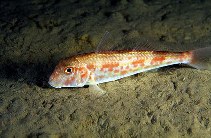Upload your photos and videos
Pictures | Videos | Stamps, coins, misc. | Google imageMullus barbatus
Picture by Luquet, D.
Pictures | Videos | Stamps, coins, misc. | Google imageMullus barbatus
Picture by Luquet, D.
Common names from other countries
Classification / Names Common names | Synonyms | Catalog of Fishes(genus, species) | ITIS | CoL | WoRMS | Cloffa
Teleostei (teleosts) > Mulliformes (Goatfishes) > Mullidae (Goatfishes)
Etymology: Mullus: Latin, mullus = soft (Ref. 45335).
More on author: Linnaeus.
Etymology: Mullus: Latin, mullus = soft (Ref. 45335).
More on author: Linnaeus.
Issue
Mullus barbatus barbatus Linnaeus, 1758 and Mullus barbatus ponticus Essipov, 1927 (restricted to Black and Azov Seas) are constantly recognized as subspecies rank, including in Eschmeyer's CofF (ver. Nov. 2020). Related information is found under the "Stocks" link in the species summary page / More info.
Environment: milieu / climate zone / depth range / distribution range Ecology
Marine; demersal; depth range 10 - 328 m (Ref. 56504), usually 100 - 300 m (Ref. 35388). Subtropical; 58°N - 14°N, 32°W - 42°E
Distribution Countries | FAO areas | Ecosystems | Occurrences | Point map | Introductions | Faunafri
Eastern Atlantic: Norway, British Isles (occasionally Scandinavia) to Dakar, Senegal, Canary Islands, Mediterranean, including Azores and Madeira.
Length at first maturity / Size / Weight / Age
Maturity: Lm 11.5, range 10 - ? cm
Max length : 38.2 cm TL male/unsexed; (Ref. 88921); common length : 20.0 cm SL male/unsexed; (Ref. 4845); max. published weight: 680.00 g (Ref. 88921)
Max length : 38.2 cm TL male/unsexed; (Ref. 88921); common length : 20.0 cm SL male/unsexed; (Ref. 4845); max. published weight: 680.00 g (Ref. 88921)
Found on gravel, sand and mud bottoms of the continental shelf. Depth range from 10-300 m (Ref. 07313) and up to depth of 328 in the eastern Ionian Sea (Ref. 56504). Feeds on small benthic crustaceans, worms and mollusks (Ref. 4845). Marketed mainly fresh (Ref. 9987).
Life cycle and mating behavior Maturity | Reproduction | Spawning | Eggs | Fecundity | Larvae
Main reference
Upload your references | References | Coordinator : Randall, John E. | Collaborators
Ben-Tuvia, A., 1990. Mullidae. p. 827-829. In J.C. Quero, J.C. Hureau, C. Karrer, A. Post and L. Saldanha (eds.) Check-list of the fishes of the eastern tropical Atlantic (CLOFETA). JNICT, Lisbon; SEI, Paris; and UNESCO, Paris. Vol. 2. (Ref. 7313)
Threat to humans
Harmless
Human uses
Fisheries: commercial; gamefish: yes
FAO(Fisheries: production, species profile; publication : search) | FIRMS (Stock assessments) | FishSource | Sea Around Us
More information
Population dynamics
Growth parameters
Max. ages / sizes
Length-weight rel.
Length-length rel.
Length-frequencies
Mass conversion
Recruitment
Abundance
Growth parameters
Max. ages / sizes
Length-weight rel.
Length-length rel.
Length-frequencies
Mass conversion
Recruitment
Abundance
Physiology
Body composition
Nutrients
Oxygen consumption
Swimming type
Swimming speed
Visual pigments
Fish sound
Diseases & Parasites
Toxicity (LC50s)
Body composition
Nutrients
Oxygen consumption
Swimming type
Swimming speed
Visual pigments
Fish sound
Diseases & Parasites
Toxicity (LC50s)
Tools
Bio-Quiz | E-book | Field guide | Length-frequency wizard | Life-history tool | Point map | Classification Tree
| Catch-MSY |
Special reports
Download XML
Internet sources
Alien/Invasive Species database | Aquatic Commons | BHL | Cloffa | Websites from users | Check FishWatcher | CISTI | Catalog of Fishes(genus, species) | DiscoverLife | DORIS | ECOTOX | Faunafri | Fishtrace | GenBank(genome, nucleotide) | GloBI | GOBASE | | Google Books | Google Scholar | Google | IGFA World Record | MitoFish | National databases | Otolith Atlas of Taiwan Fishes | Public aquariums | PubMed | Reef Life Survey | Scirus | SeaLifeBase | Tree of Life | Wikipedia(Go, Search) | World Records Freshwater Fishing | Zoobank | Zoological Record
Estimates based on models
Preferred temperature (Ref. 115969): 13.1 - 15.9, mean 14.2 (based on 119 cells).
Phylogenetic diversity index (Ref. 82804): PD50 = 0.5625 [Uniqueness, from 0.5 = low to 2.0 = high].
Bayesian length-weight: a=0.00871 (0.00796 - 0.00953), b=3.09 (3.06 - 3.12), in cm Total Length, based on LWR estimates for this species (Ref. 93245).
Trophic level (Ref. 69278): 3.1 ±0.1 se; based on diet studies.
Resilience (Ref. 120179): Medium, minimum population doubling time 1.4 - 4.4 years (K=0.11-0.5; tmax=11).
Prior r = 0.68, 95% CL = 0.45 - 1.02, Based on 27 full stock assessments.
Fishing Vulnerability (Ref. 59153): Low to moderate vulnerability (32 of 100).
Climate Vulnerability (Ref. 125649): Low vulnerability (13 of 100).




